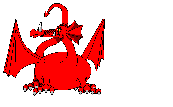The page of Brithenig

`Yn nediwn seint yn llinghedig, yn nediwn seint yn cor'
Questions are formed by changing the word order of the subject and the
verb:
Gw pharlath Brithenig, `You speak
Brithenig'.
Parla'gw Frithenig?, `Do you speak
Brithenig?
Note the change in sentence order causes softening to occur on following
words. Also the -th ending on the verb has been
elided.
When the subject is a noun it remains before the verb but the equivilent
pronoun is placed after the verb:
Ill car es llâ, `the car is there'
Ill car es-ys llâ?, `is the car there?
Brithenig has a set of question words similar to English:
Ki?, who?
Di ghi?, whose?
Ke?, which?
Ke gws?, what?
K'lwg?, where?
A ch'lwg?, to where?
Di g'lwg?, from where?
Co?, how, what kind of?
Cant?, how much, how many?
Ke sig?, how?
Ke dem?, when?
Perch?, why?
Question words come at the beginning of sentences, except for
di ghi:
Ke gar es-ô?, Which car is that?
Ill car di ghi es-ô?, Whose car is that?
Coand ke replace the article and
cause softening. Other question words which act adverbially cause
following verbs to soften.
Ke sig? is used with adjectives:
Ke si wirdd er gwstr cum?, `How green was your
valley?
In answering the word order is retained with the question word
replaced:
Ke gws es gwstr nôn? - Rhaifun eo f'affell,
`What is your name? - I am called Ray'.
Brithenig speakers can put the interrogative tag es-sa
rhen, isn't it? at the end of sentences. The tense of
the verb and the number and gender of the pronoun may change, but, unlike
English, the negative rhen is not dropped:
Gw h-affellath Padrig, es-ys rhen?, Your name is
Patrick, is it not?
Ty fi nglafaf rhen, er-ty rhen?, You didn't call
me, did you?

